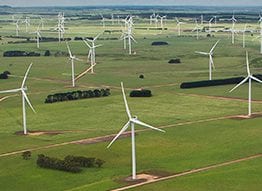Macarthur wind farm – the largest in Australia and the southern hemisphere – was officially opened in south western Victoria on Friday by the local member and state premier Denis Napthine. The 420MW wind farm, built at a cost of $1 billion by AGL Energy and New Zealand company Meridian, is the biggest single investment in renewable energy in the country since the Snowy Mountain hydro project was completed in the 1970s, the companies say.
The Macarthur wind farm will nearly double AGL’s wind farm portfolio to 924MW, and lifts it above hydro for the first time. Wind now accounts for 16 per cent of its generating capacity, compared to 14 per cent for hydro (Coal is 37 per cent and gas is 33 per cent).
The project was welcomed by Climate Change Minister Greg Combet, who said the capacity of wind farms in Australia had risen from 1,140 MW when it was first elected in 2007 to nearly 3,000MW today.
“Wind farms with asset lives of 25 years or more need stability in climate change policy to justify these investments,” Combet said. “The Coalition needs to make clear to the wind industry and regional Australia whether it supports the legislated 41,000 GWh Large-scale Renewable Energy Target which will ensure more than 20 per cent of Australia’s energy comes from renewable sources by 2020.”
Here are some interesting vital statistics:
It’s the largest wind farm in Australia, and in the Southern Hemisphere
It’s also the most expensive, at $1 billion.
It’s the largest investment in Australian renewable energy since the Snowy Hydro Scheme in 1974.
Dimensions:
It features the largest wind turbines installed in Australia. Vestas V112-3.0MW turbines with an 85m tower height and 55m blade length. (It was originally going to use 174 Suzlon S88 turbines for a total capacity of 365MW, but AGL Energy got a better deal with Vestas that allowed it to reduce the number of turbines and increase capacity).
All the towers were produced in Australia, with Portland-based Keppel Prince Engineering building 80 tower sections, and Adelaide-based RPG Australia (which entered administration last year) building 60 tower sections.
The wind farm required 56,000 cubic metres of concrete, with 400 cubic meters (the equivalent of 80 concrete trucks) required for the foundations for each of the 140 towers. About 1,120 heavy lifts were required to joint the tower sections, nacelles, hubs and blades.
The wind farm has three substations and 3 main substation transformers. Construction commenced in October 2010, and were completed in January, 2013 – three months ahead of schedule.
Location:
In the western districts of Victoria, about 300kms from Melbourne. It is located on three properties primarily used for sheep and cattle herding, and covers 5,500 hectares some 16km east of Macarthur, between Hamilton and Warnambool.
Output:
The wind farm says it will produce enough electricity to power about 220,000 average homes in Victoria, and abate more than 1.7 million tonnes of greenhouse gases each year.
According to a 2010 press release, Macarthur is expected to have a capacity factor of 35 per cent (about average for Australian wind farms), with an average wind speed of 7.6 metres/second.o
Jobs:
It created 644 direct jobs in Australia and a total of 2,183 direct and indirect jobs. About 30 staff operating and maintaining the wind farm will be employed directly for its 25- year expected life-span.










